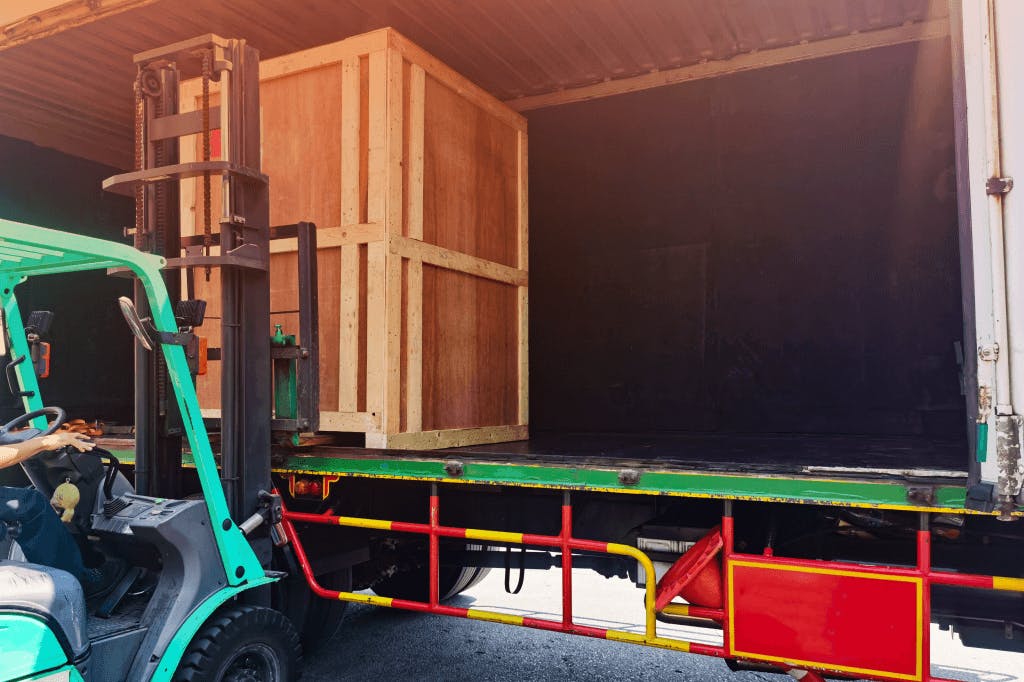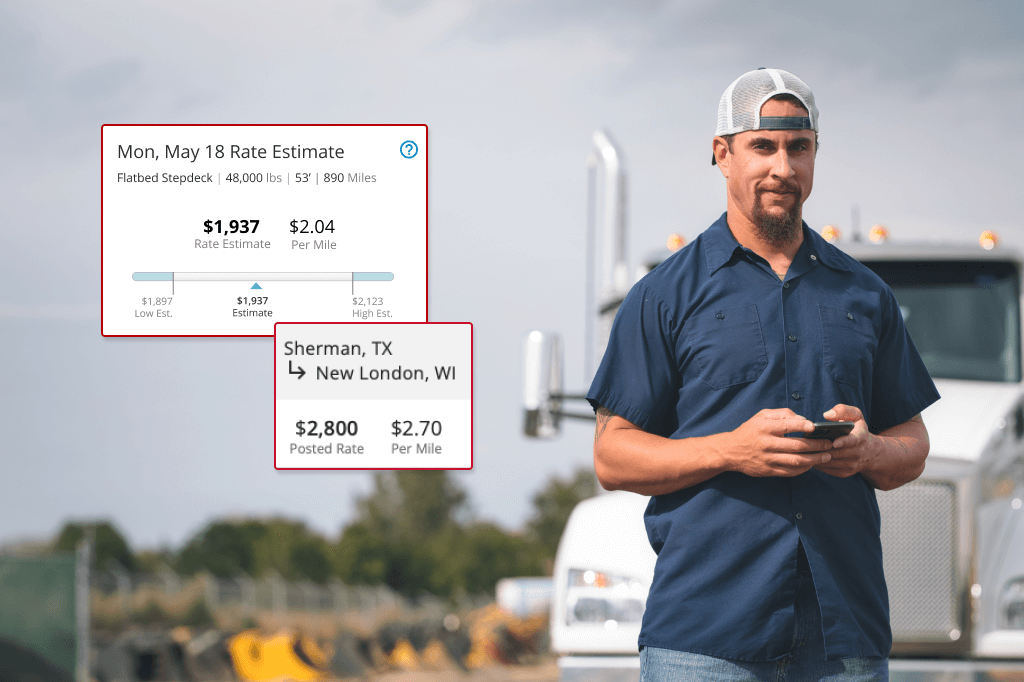How to Calculate (& Find) the Best Truck Freight Rates

Calculating the best freight rates can be complex. While you need to be competitive, you also need to be profitable. It’s tricky to constantly weigh supply and demand, offering competitive rates that still make you money.
You need to take into account your fixed costs of doing business. These are the expenses you’ll pay every month, whether you move any goods or not, such as insurance, equipment leases or payments, and permitting. You’ll also need to factor in your variable costs, such as maintenance and repairs, taxes, and paying your truck drivers. Together, these things help determine your base rate or the amount you need to charge to break even.
Make data-driven decisions.
Grow your business with competitive pricing and negotiating.
Let’s say your base rate is $1.80 a mile, and anything above that is pure profit. Want a 20% margin? You’ll need to charge a minimum of $2.16 per mile. Knowing your base rate is crucial, but it’s just one step in the process.
What are truck freight rates?
The trucking freight rate is the price a shipper or broker will pay you — as the carrier — to haul a load. It’s simple in concept, but as you know, rates can vary significantly, even within the same lanes. Having current and accurate information about the average rate for your loads and lanes is essential to pricing and negotiating rates properly.
How are trucking freight rates calculated?
Trucking rates are calculated on a per-mile basis. First, take the mileage between the starting and destination points. Then divide the total rate by the number of miles between destinations to get your trucking freight rate.
TOTAL RATE DIVIDED BY MILEAGE = PER-MILE FREIGHT RATE
Let’s say you’ve got a load that’s headed to Miami from Atlanta. Depending on your exact pickup and drop-off locations, the distance is roughly 675 miles. If the total rate is $3,200, the per-mile freight rate would be $3,200 / 675 = 4.74. In this case, the rate would be $4.74 per mile.
Of course, calculating the overall rate to charge will depend on various factors besides just the mileage.
Available routes and loads
A big part of calculating rates is determining your fleet and driver availability (and capacity!), along with the available routes and the loads you’ve already taken on. You may want to charge more for a problematic load or one that will require you to reroute a driver significantly.
Shipment weight
The weight of the shipment is a significant factor. To control costs, you have to carefully manage the overall weight loading for your fleet. If you start with a higher rate for heavy loads, even if the shipper negotiates a discount, you will still end up with more total revenue.
Freight classification
In the freight logistics industry, each type of shipment has a specific classification. The National Motor Freight Traffic Association (NMFTA) has defined 18 classes of commodity shipments. Several factors determine freight class, including:
- Product density
- Liability
- Product value
- Handling needs
- Stowability
Taken together, these factors determine the load’s transportability. Less transportable loads often command a higher rate.
Shipping method
There are five basic freight shipping methods:
- Full truckload (FTL)
- Partial truckload (PTL)
- Less than truckload (LTL)
- Intermodal
- Expedited
Full truckload (FTL)
As you’d expect, FTL applies to a shipment that takes up an entire trailer. It doesn’t matter whether it’s the smallest truck in your fleet or the largest. You’re using up the whole space within your hauler. Typically, FTL freight will exceed 15,000 pounds.
Partial truckload (PTL)
When a load doesn’t fill an entire trailer, it’s a partial truckload. Carriers can take on multiple shipments to earn more per mile and maximize their earnings per trip. Partial truckloads are typically point-to-point, so freight loaded onto a truck stays on board until its destination. But with different shippers, there might be different locations. PTLs are charged per mile, pro-rated by weight and dimension.

Less than truckload (LTL)
A less than truckload shipment is similar to a PTL in that it doesn’t take up an entire trailer. However, it might need to move between vehicles during the shipping process. Rates will vary depending on whether you can match loads from freight brokers with similar destinations.
Intermodal
An intermodal freight shipment involves multiple shipping methods. For example, it’s intermodal if a load needs to ship by road and rail. Because non-road carrier rates are usually less expensive, intermodal shipping typically costs less. But it can also be less profitable for freight carriers if you’re not careful about estimating rates.
Expedited
The highest rates typically come from expedited shipping. Freight transported in express shipping lanes, such as overnight or direct routes, commands higher rates.
Dry van rates
Besides freight type, weight, and density, dry van rates are also impacted by other factors.
Distance
The most significant factor is delivery distance, which involves gas, vehicle wear and tear, and mileage. Rates also need to be calculated based on whether you’re using an established shipping lane between hubs or major cities or if it’s a rural or atypical route.
Supply and demand
Supply and demand are frustrating for shippers and why market rates can vary so greatly. When setting rates, you have to consider the number of trucks and drivers available along with what you’ve already committed to handling.
Seasonal demands
Rates can also vary by season. For example, summer is often a heavy time for shipping fresh produce from agricultural areas. This can significantly impact the number of available trucks and increase rates.
Reefer freight rates
The same factors that apply to dry van freight also apply to reefer freight shipments of goods that require temperature control. Also, you need to consider additional regulations that can impact pricing.
Make data-driven decisions.
Grow your business with competitive pricing and negotiating.
While all loads are subject to some regulations, perishable goods such as produce must follow additional state and local regulations. For example, some items might require inspection before being shipped across state lines. Other cargo types must be shipped locally or only in designated areas, which can add costs due to loading, unloading, or working with other third-party carriers.
What types of trucking freight pay the best rates?
To maximize your profitability, you’ll want to move more freight that pays a higher trucking freight rate.
Typically, flatbed rates are the best, but those can vary too if you’re carrying special equipment or a large haul that can’t fit into a container. LTL shipments typically pay higher rates than full truckloads because drivers make multiple stops and might need to handle loading and unloading.
Routes and cargo also impact rates. In particular, these types of loads tend to pay significantly more than the average:
- HAZMAT freight. As you might expect, hauling hazardous materials carries some inherent risks. You’ll also need a special endorsement. These two factors raise the rates you can charge.
- Ice road freight. Likewise, driving on a road made of pure ice isn’t for the faint of heart. Ice road truckers command the highest rates of all, and you can still drive traditional routes during the off-season.
- Liquid and gas tankers. Liquid and gas loads tend to be unstable. Safety is paramount, and you will need a special endorsement. Expect to charge more for these challenging loads.
- Oversized freight. Transporting heavy machinery and other oversized loads takes specialized skills and licensing. Because the job is so complex, the rates tend to be higher.

How to find the best trucking freight rates
As you can see, competitive trucking rates vary dramatically depending on everything from the type of equipment you have to the routes you drive and the cargo you transport. Your base rate is the minimum you need to make to break even, but your actual rates may be significantly higher based on your choices. Truckstop offers numerous tools to help carriers negotiate the best rates.
- Gauge load activity by origin and destination with load density. Perform unlimited load searches. Find out how many trucks are already in the lanes you want to travel and whether negotiations will be favorable, balanced, or unfavorable.
- Monitor load-to-truck ratios. Load-to-truck ratios can help you negotiate rates. In general, as the number of available trucks rises, rates go down. As the number of available loads rises, rates go up. Monitoring load-to-truck ratios can strengthen your negotiations.
- Search high-paying loads across lanes. Find out which loads pay the highest rates, regardless of which lane you choose.
- Get rate recommendations by lane and load type. With a combination of real-time data and monthly trends, you’ll get the recommendations you need to set your rates with confidence with Rate Insights.
Find truck freight rate trends and estimates on the Truckstop Load Board. You can check rates against hundreds of thousands of daily loads. By filtering your results based on location, destination, trailer type, weight, dates, and other factors, you can see what loads are available and view rate data.
With Truckstop, you can say goodbye to “guesstimates.” Predictive data analysis helps you plan and compare your rates against regional trends to make the best freight rate decisions. Sign up today or request a free demo.
Listen up!
Check out our podcast, Freight Nation, where industry experts talk all things trucking.

Find out how our platform gives you the visibility you need to get more done.
Get helpful content delivered to your inbox.
Schedule a demo.
Find out how our platform gives you the visibility you need to get more done.





